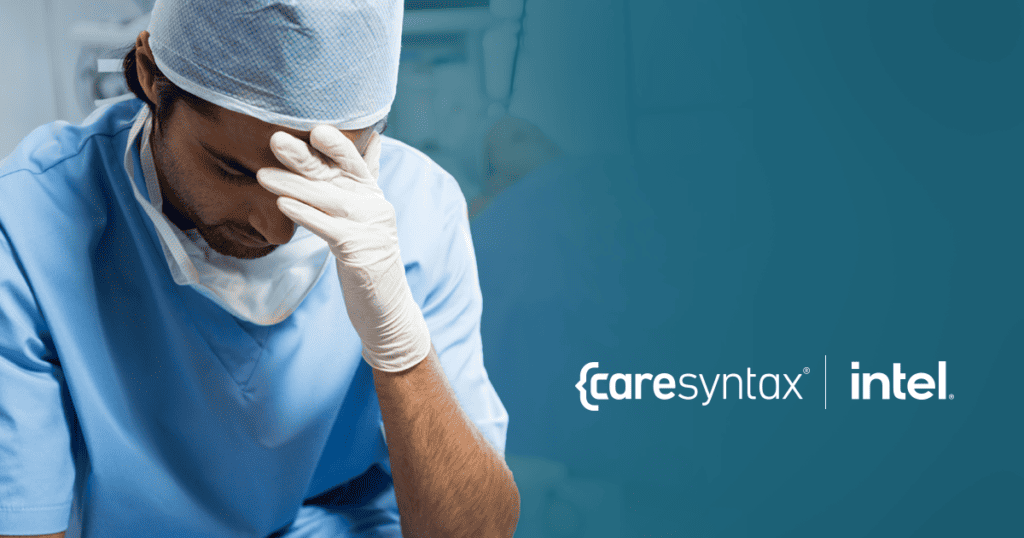
Blog
Caresyntax & Intel Collaborate to Address Surgical Staffing Shortage
Learn More

Caresyntax Blog
September 14, 2021
Q&A with Gail Pietrzyk, Corporate Director of Surgical Services, Universal Health Services
In the operating room where every minute counts, time is the most valuable — and elusive — resource a surgeon has. Even before the COVID-19 pandemic, health systems and hospitals sought ways to optimize their processes to serve more patients. Now, with surgical caseloads poised to exceed pre-pandemic levels, the need for data insights to improve decision making, increase efficiency, and drive peak performance has never been greater. We sat down with Gail Pietrzyk, DNP, RN, CNOR, Corporate Director of Surgical Services at Universal Health Services, to discuss how UHS incorporated Caresyntax analytics to create a more efficient operating suite.
A: We started working together in 2016 when we were looking for a solution for our block dilemma. Prior to working with Caresyntax, we were only able to get reports from our electronic medical records system, but physicians would regularly take issue with the findings because the reports weren’t always accurate. Overall, our block utilization reports were extremely poor. We looked at Caresyntax to help us with block data management tools, because getting accurate reports that physicians could have confidence in was extremely important. We decided to give Caresyntax a try, and the rest is history. It’s been a great partnership and we’ve learned a lot from each other along the way.
A: Working with Caresyntax allowed us to access a whole dashboard of metrics. There are around 20 different reports that Caresyntax offers that we can drill down to the case level; it has made reporting so much easier for our directors. They can have a report within four or five clicks, and they can pull the data, orient it graphically, and export it as a PDF so it’s ready to drop into a PowerPoint presentation for Department of Surgery meetings and Surgery Executive Committee meetings. It really simplified everything for the Surgery Directors in terms of being able to get actionable data. When we decided to go with Caresyntax, I didn’t realize how much of a benefit that would be, but it has been a big plus.
In addition to the dashboard, Caresyntax has the ability to benchmark dashboard metrics with all other facilities (or segmented by a variety of measures) in the Caresyntax database. The tool compares dashboard metrics with our definitions – so it is a true apple-to-apples comparison. This has been extremely valuable in recognizing our performance improvement and quality metrics compared to other facilities. For example, we have been able to demonstrate consistent top quartile performance for our OR Turnover times and were able to compare our volume trending to other systems in the Caresyntax database throughout COVID recovery and surge timeframes.
A: I always say that I don’t want my directors spending time trying to get the information. They need to be working on solutions to the opportunities that the information tells us. If they spend a half hour or an hour figuring out how to get data and making it presentable, that’s just a waste of their time.
A: It was a group decision. My VP at the time was part of the evaluation team along with business development and corporate IT. We piloted at a few sites, and the pilots worked out well. We decided to go with it. At that time, there were not a lot of systems on the market that did this type of analytics. Since then, the competition field has really grown, but at that time, Caresyntax was really the front runner.
A: After we implemented Caresyntax’s platform, the first feedback from sites was, “Oh this data is wrong,” because nobody wanted to think that their numbers for block utilization, capacity and other metrics were actually correct. In the beginning, we spent 3-6 months working with the Caresyntax team and each facility in the system to ensure data integrity and prove that everything was accurate. From there, we worked on improvements. We started off getting everyone to implement their Surgery Executive Committees, putting their governance together, and compiling best practices for block improvement. We would visit each site and conduct “block blitzes,” where we would review all the dashboard metrics and focus specifically on how the site could improve their blocks. We did this annually and refined and added new metrics. Now, we focus on the block metrics, stewardship, and the financial picture so that we have a holistic view of how our ORs are being used.
Caresyntax has been integral with our block improvements. They would go out in the field with us to do the block blitzes with several facilities a week at a time. It has truly been a partnership where I can do the best practice recommendations and Caresyntax will pull the data during these meetings. This supports us to have a good discussion regarding metrics and individual block opportunities.
One time we were at a facility and the block utilization was not where we wanted it to be, so Caresyntax’s Director of Customer Success, Laura Stewart, began to drill down into the application. You can do so much with Caresyntax; you can slice the data many different ways with just a few clicks. Laura identified a certain physician was never using their block the third week of the month, and we were able to look at the reports and figure out he was taking cases with one type of insurance to another hospital. We saw that this was an opportunity to either contract with this insurance or give that OR time to someone else. We never would have been able to look at this data without Caresyntax, and it’s something that we just can’t do with our electronic medical record system.
A: In the beginning, we were just trying to learn as much as we could about the virus, and our number one priority was keeping our staff safe while providing safe patient care. Many of our surgical departments handling elective procedures were legislatively shut down due to the pandemic and it felt like we were playing whack-a-mole. At first the east coast flared up, then Texas hit during the summertime, then the Nevada and California markets would go up, quickly followed by Oklahoma and Texas again.
Caresyntax helped us a great deal with our business resumption planning. The minute we curtailed elective surgeries in March 2020, we started thinking about how we could open back up. Caresyntax was able to provide us with great information about capacity management and then we were able to match this with our list of cancelled or pending patients. We kept a very close eye on all of the surgeon offices. We helped each facility develop a business plan for surgery resumption based on their own data. The capacity management tool worked very well to help us identify capacity and figure out how our capacity would be affected if we extended our hours or opened on weekends, for example. Those were all things that without Caresyntax, we would not have a good handle on.
A: My two favorite reports are the concurrent utilization and the block utilization heat map. The concurrent utilization shows how many ORs are running at any given time. We can look at that by day of week, time of day, etc. This helps identify if we should run more ORs at a given time of day or if weekend staffing should be implemented vs. on-call staffing. The block utilization heat map quickly shows which blocks to focus on for the greatest impact.
A: I’m very excited about some of the new things that we’re working on. We’re a pilot site for automated surgeon and office alerts about open times and unused blocks. We’re going to get that operational and we want to put this out system wide as soon as we can. I’m also excited about AI development being able to predict case volumes and block utilizations. This will be hugely beneficial for us and we’ll be able to have a telescope into the future, so to speak. I’m also anticipating the release of the PACU dashboard. This will give us similar information to the OR Dashboard for PACU. We can then focus on PACU opportunities for utilization, capacity, and LOS.